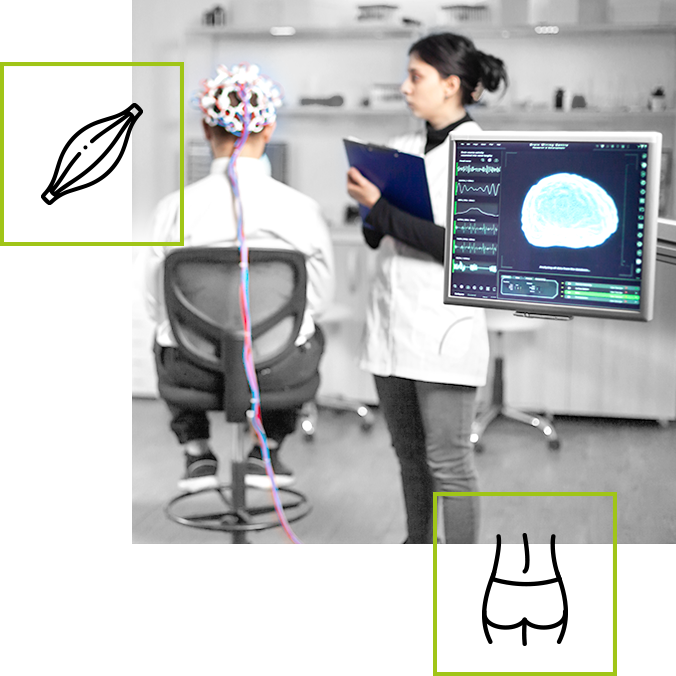Vibrotherapy improves quality of life for multiple sclerosis patients
Vibrotherapy has been used in patients with relapsing-remitting multiple sclerosis, showing improvements in various motor and neuromuscular functions.
How does it work?
Whole-body vibration is a method of passive neuromuscular training that can have a positive effect on the mobility and postural control of patients with multiple sclerosis. In addition, vibrotherapy also has positive effects in other neurological diseases, such as cerebral palsy, stroke and Parkinson’s disease.


When and for whom?
People with multiple sclerosis (MS) have weaker and less robust core muscles compared to healthy people. A form of training through passive muscle-activating massages, such as vibrotherapy, is a suitable form of rehabilitation and support for MS treatment.
Effectiveness
The study by Abbasi et al. (2019) shows that 6-week vibration training can positively affect core muscle strength and endurance and quality of life in patients with multiple sclerosis. In addition, the vibrotherapy used was well tolerated by patients and no adverse effects were observed.

Marco Paoloni, Morena Giovannelli, Massimiliano Mangone, Laura Leonardi, Emanuela Tavernese, Elisabetta Di Pangrazio, Andrea Bernetti, Valter Santilli, Carlo Pozzilli. Does giving segmental muscle vibration alter the response to botulinum toxin injections in the treatment of spasticity in people with multiple sclerosis? A single-blind randomized controlled trial. Clin Rehabil. 2013 Sep;27(9):803-12.
Benefits of vibrotherapy

No side effects

Action confirmed by scientists and practitioners

Perceptible effects from 1 treatment

Long-lasting effects through systematic use
Choose the right product
We will help you select a set of modules that suits your conditions.
Multiple sclerosis (MS)
Multiple sclerosis (MS) is a chronic autoimmune disease that affects the central nervous system, including the brain, spinal cord and optic nerves. In MS, the immune system attacks the myelin sheaths around nerve cells, leading to nerve damage and disruption of nerve signal transmission. The symptoms of MS are varied and can include problems with movement, balance, vision, as well as neurological and cognitive symptoms. The disease usually develops gradually, and its course varies from patient to patient. MS is a chronic condition that requires a multidisciplinary approach to treatment, including both drug therapies and rehabilitation.
Physiotherapy in the treatment of MS
Physiotherapy for multiple sclerosis (MS) includes a wide range of activities aimed at improving motor function, maintaining independence and alleviating symptoms of the disease. Physiotherapists focus on general muscle strengthening, improving balance and coordination, as well as aerobic exercises. Patients learn relaxation techniques, breathing training, and the use of various rehabilitation equipment. Manual therapists may use techniques to reduce muscle stiffness. Everything is tailored to the individual patient's needs, with flexibility in the plan as the disease progresses. Cooperation with the physiotherapist is key to achieving maximum benefit from physical therapy.
Multiple sclerosis and muscles
MS is a chronic and debilitating immune-mediated disease of the central nervous system. It occurs most often between the ages of 20 and 40, with women at higher risk. Patients with MS tend to have less muscle strength and endurance compared to healthy individuals. Physical training appears to be an important part of physiotherapy in this disease, but some exercise programs are not well tolerated by patients and many consider discontinuing physiotherapy for this reason. In such cases, vibration therapy is suggested as a safe form of muscle activation, an alternative method of physiotherapy treatment Physiotherapy for multiple sclerosis (MS) includes a wide range of activities aimed at improving motor function, maintaining independence and benign
MS and vibrotherapy
Here are some benefits and issues associated with vibration therapy in the context of multiple sclerosis:
- Improving muscle function: Vibration can help stimulate muscles, which can be beneficial for improving muscle strength, flexibility and motor coordination.
- Improving balance and coordination: Vibration can affect proprioception (the body's ability to recognize body position in space), which can improve balance and coordination in people with MS.
- Reduce muscle stiffness: Some people with MS may experience muscle stiffness. Vibration can help alleviate this symptom.
- Improving blood circulation: Vibration can improve blood circulation, which can be beneficial to overall cardiovascular health.
However, it should be noted that each case of MS is unique, and the effects of vibrotherapy may vary depending on the severity of the disease and the individual needs of the patient. In addition, it is always important to consult a doctor before introducing any new therapy, including vibrotherapy. A health professional will be able to assess whether vibration is safe and effective in a particular case and tailor the therapy to the patient's specific needs.





